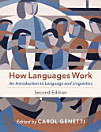A Grammar of Dolakha Newar
Carol Genetti
ফেব্ৰু ২০০৯ · Mouton Grammar Library [MGL] কিতাপ 40 · Walter de Gruyter
৫.০star
২ টা পৰ্যালোচনাreport
ইবুক
610
পৃষ্ঠা
reportমূল্যাংকন আৰু পৰ্যালোচনা সত্যাপন কৰা হোৱা নাই অধিক জানক
এই ইবুকখনৰ বিষয়ে
A Grammar of Dolakha Newar is the first fully comprehensive reference grammar of a Newar variety. Dolakha Newar is of particular interest as it is member of the mutually unintelligible eastern branch of the family, so allows for an important comparative perspective on this significant Tibeto-Burman language. In addition to a chapter on phonetics and phonology, the book contains a separate chapter on prosody. There are also distinct chapters on each word class, with full discussion of the morphological and syntactic properties of each class. The book provides an extensive study of syntax, including complete chapters on constructions, clause structure, constituent order, grammatical relations, nominalization, complementation, the participial construction, and the complex sentence, as well as a detailed chapter on tense and aspect. Brimming with examples from natural discourse, the book couples rigorous description of the language's structures with full discussion of how the structures are used in connected speech. Each analysis is presented with full argumentation and competing analyses are contrasted and discussed. The result is a rich, readable, and beautifully argued portrait of a language and how it works.
মূল্যাংকন আৰু পৰ্যালোচনাসমূহ
৫.০
২ টা পৰ্যালোচনা
লিখকৰ বিষয়ে
Carol Genetti , University of California, Santa Barbara.
এই ইবুকখনক মূল্যাংকন কৰক
আমাক আপোনাৰ মতামত জনাওক।
পঢ়াৰ নির্দেশাৱলী
স্মাৰ্টফ’ন আৰু টেবলেট
Android আৰু iPad/iPhoneৰ বাবে Google Play Books এপটো ইনষ্টল কৰক। ই স্বয়ংক্রিয়ভাৱে আপোনাৰ একাউণ্টৰ সৈতে ছিংক হয় আৰু আপুনি য'তে নাথাকক ত'তেই কোনো অডিঅ'বুক অনলাইন বা অফলাইনত শুনিবলৈ সুবিধা দিয়ে।
লেপটপ আৰু কম্পিউটাৰ
আপুনি কম্পিউটাৰৰ ৱেব ব্রাউজাৰ ব্যৱহাৰ কৰি Google Playত কিনা অডিঅ'বুকসমূহ শুনিব পাৰে।
ই-ৰীডাৰ আৰু অন্য ডিভাইচ
Kobo eReadersৰ দৰে ই-চিয়াঁহীৰ ডিভাইচসমূহত পঢ়িবলৈ, আপুনি এটা ফাইল ডাউনল’ড কৰি সেইটো আপোনাৰ ডিভাইচলৈ স্থানান্তৰণ কৰিব লাগিব। সমৰ্থিত ই-ৰিডাৰলৈ ফাইলটো কেনেকৈ স্থানান্তৰ কৰিব জানিবলৈ সহায় কেন্দ্ৰত থকা সবিশেষ নিৰ্দেশাৱলী চাওক।







